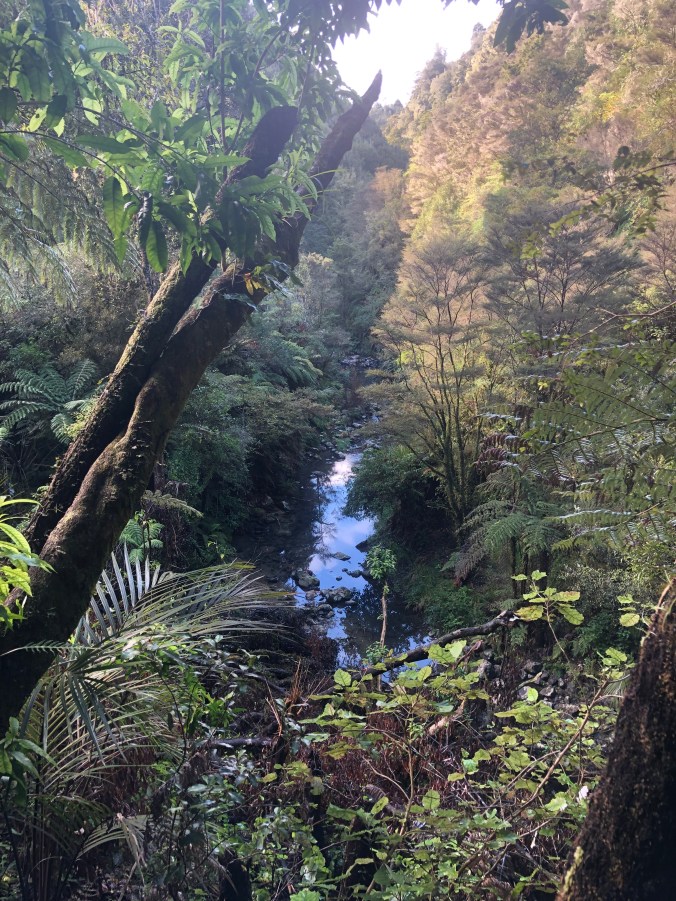A one hour drive from downtown Auckland is all it takes to reach a very popular scenic spot; Hunua Falls, located on the western boundary of Hunua Ranges Regional Park. In summertime there are crowds of tourists and lots of swimmers in the water, but in wintertime, not so much…

At 30 meters high the falls are an impressive sight, the white foamy water strongly contrasting the black basalt rock, which formed in lava flows over half a million years ago.
The falls are a two minute walk from the parking area, but before you can set foot on the trail you have to thoroughly clean your boots.
Kauri tree dieback disease is an ongoing problem in many North Island forests. The Kauri tree is New Zealand’s largest native tree — over 50m tall, with a trunk diameter over 5m! — and is a cultural icon, so the government is taking the challenge very seriously. The disease is caused by an oomycete fungus, Phytophthora agathidicida, that likely was inadvertently brought into New Zealand over 60 years ago, but was only identified in 2008 (more details). Before entering Hunua Ranges park, you need to scrub the dirt off your shoes and hiking pole tips and use the fungicide spray provided. Some hiking tracks have even been closed to limit the spread of the disease. Here is the full list of tracks that are closed.
After carefully cleaning our boots, we took the Cossey Gorge Track to Cosseys Dam, one of four reservoirs in the area that provide water to Auckland. The track is pretty easy, except for the 327 carefully constructed steps near the start; straight up! It is a very well maintained track, and the creek crossing was no problem.
The forest vegetation was spectacular. Large expanses of New Zealand tree ferns created their own special kind of forest.
Numerous other species of small ferns carpeted areas alongside the trail, and rivulets of water darkened the rock.
It had the feel of a tropical rainforest, but much more pleasant because the air temperature was just 10C and the humidity was pleasantly low.
Plus, we heard the coolest bird calls! Using the iTalk app I recorded a really remarkable call (which I later decided is probably the Tui bird) saved it as a .aiff file and converted it to .mp3 on imedia.io. Turn up your volume and click on the play icon: (sorry, I don’t know why that audio file link does not display as an icon)

Next > Exploring Auckland, On Foot
Note about Waikatere Ranges Tracks and Kauri Dieback Disease
Kauri Dieback disease is killing kauri trees in the Waitakere Ranges Regional Park (west of Auckland) and in other forests on the North Island. The closure of some Waitakere tracks and the creation of protection zones helps prevent the spread of this disease, but anyone using the park can play their part to save kauri. Track users are asked to observe these guidelines when visiting:
- Always make sure your shoes, tyres and equipment are cleaned to remove all visible soil and plant material before and after visiting kauri forest.
- Always use the cleaning stations installed on major tracks.
- Stay on the track and off kauri roots.
- Keep your dog on a leash at all times or leave them at home.
Find out more about Kauri Dieback and the track closures here. This map of the Waitekere Ranges shows the currently open tracks in that park.
The closures are strongly objected to by some of the local residents who claim that the research supporting the closures is flawed and that the Auckland Council is simply closing trails indefinitely without a plan. Scientists disagree, saying humans are the primary reason Kauri Dieback is spreading (other animals like wild pigs are also a vector, and hunting contracts have been awarded to try to reduce their numbers). The Council says there is a plan and funding to upgrade the closed tracks over the next decade so they are not muddy (the fungus pathogen causing the disease can spread through water moving through the soil) and it appears the vast majority of New Zealanders support the track closures.
I think the people objecting to the track closures aren’t looking at the big picture, and expect too much, too soon. Speaking as a biologist, I would tell them that if more Kauri trees die that can radically alter the forest they love because other plant species depend on the Kauri to thrive, as they are a foundation species. Yes, in the 19th century many New Zealand forests were heavily logged and stripped of most of their vegetation, which then grew back. But Kauri trees take centuries to reach maturity. We have to think long term and give the forest a chance to recover, and we need data collected over years to make intelligent decisions. Short term thinking, believing that closing trails for months or a few years will solve the problem, is not the solution. I may be criticized as an “outsider” for taking that position, but science and rational analysis isn’t limited by national boundaries; it applies everywhere.
When I planned our trip to New Zealand last year I first read about the Hillary Track in the Waitakere Ranges National Park and got excited thinking about hiking it. Then I learned that most of the tracks in the National Park were closed due to Kauri Dieback. I adjusted my expectations and during our time in Piha am enjoying the tracks that remain open.








Pingback: Volcano Hiking on Rangitoto in New Zealand | Electric Travels